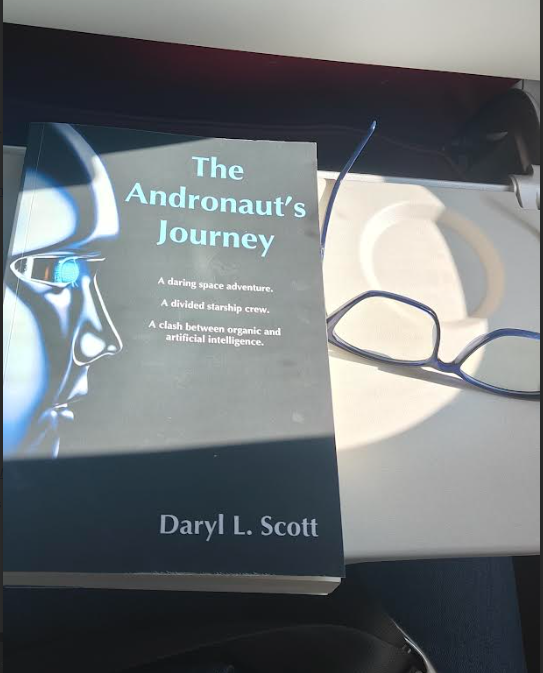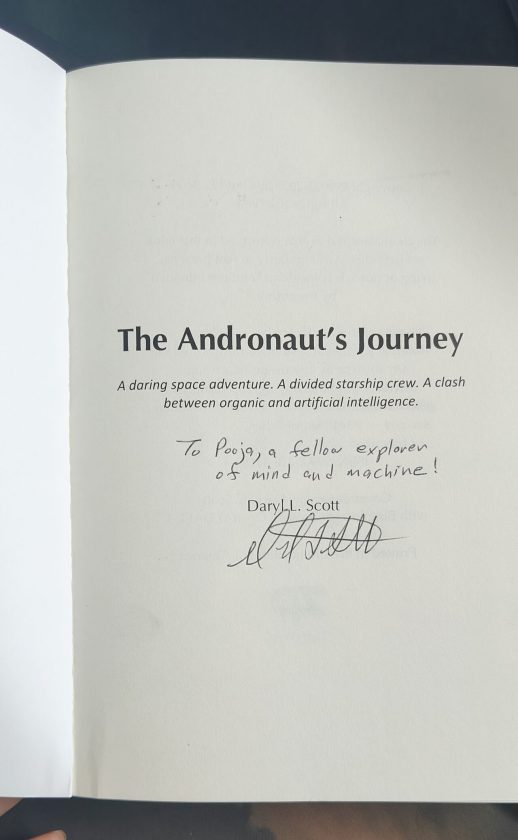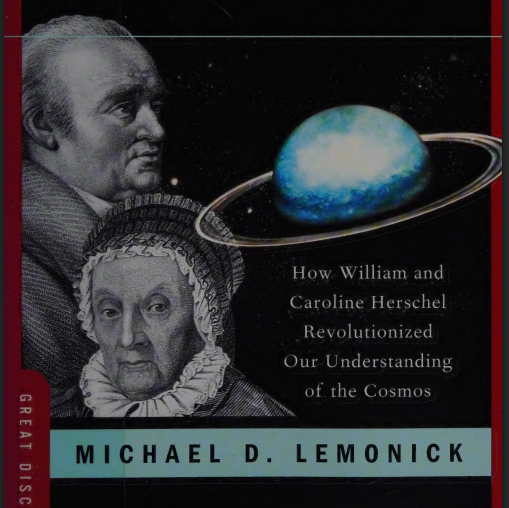Last week I was flying across cities because of office work and this time, I was accompanied by Daryl L. Scott’s debut novel The Andronaut’s Journey.
Daryl L. Scott is a tech innovator turned author who’s spent his life riding the waves of technological change, from the days of programmable calculators to the dawn of Artificial Intelligence. He’s led teams building early PDAs, voice applications, and cutting-edge mobile platforms, leaving his mark across industries from marketing to business intelligence. Now, he’s bringing that same curiosity and insight to fiction, weaving his years of tech experience into stories that explore where innovation might take us next.
I’ve spent most of my adult life devouring science fiction, the plots that take you light-years away from your living room couch or in this case, your airplane seat. Give me a beat-up spaceship, a crew with trust issues, a healthy dose of AI and a mission that could go sideways at any moment, and I’m home.
But having robots as protagonists, I’m not too sure. They always felt too calculated, and so… well, robotic. Of course, I enjoyed I, Robot as a teenager and found Ex Machina unsettling in all the right ways, yet I’d say, I fall on the side of those who see robotics as a support system, the ones that don’t see them going rogue.
So when Daryl L. Scott himself handed me a copy of The Andronaut’s Journey, I wasn’t sure what to expect.
I opened the book on a cross-country flight. The total time for my round trip was about four and a half hours, and with a few extra reading sessions here and there, I managed to finish it in less than a week.
Zaylen-1: More Than Just a Machine
Scott doesn’t waste time with preamble. Within the first chapter, we’re on the starship Novara, orbiting a dying dwarf planet called Kelvadra that’s literally tearing itself apart. Earth is on the brink of environmental collapse, energy wars are brewing, and humanity’s last hope is a rare isotope called Tridisiom that exists on this volatile world.
This is the kind of setup that can make anyone’s pulse quicken. Remember that scene in Interstellar, when the crew lands on Miller, the water planet orbiting Gargantua and every distant wave feels like a ticking clock counting down their chances of survival? That’s the kind of tension I live for and Scott delivered plenty of it.
Right at the beginning we are introduced to Zaylen-1, the first of the Zaylen Series Andronauts. He’s covered in synthetic skin that makes him look almost human, equipped with advanced AI, and designed to think independently. He’s genuinely trying to understand what it means to work alongside humans and to be valued by them.
This reminds me of Isaac Asimov’s The Positronic Man, where Andrew spent two centuries legally fighting for human status and Data pursued an idealized version of humanity, Scott does something different. Zaylen doesn’t want to become human. He wants humans to expand their definition of personhood to include beings like him. It’s less about transformation and more about recognition, and that distinction matters.
A Spacewalk That Sets Everything in Motion
There’s this scene that hooked me completely. It’s early in the book, and Zaylen is on his first spacewalk with Commander Elara Thorne to repair the Novara’s damaged communications array. The planet below them is stunning and terrifying, a patchwork of rich ochres, deep blues, and vibrant greens with swirling lavender and magenta atmosphere. They’re working fast because Kelvadra’s volcanic activity is ramping up, and every now and then there is some wave of debris hits.
The way Scott describes space work is perfection.There’s the precision required for every movement, the casual expertise of someone like Elara who’s done this a hundred times paired against Zaylen’s hyper-analytical approach. And then, in a heartbeat, everything changes.
Zaylen spots a reflection in Elara’s helmet, a rock fragment growing exponentially larger with each passing second. Without hesitation, he lunges toward her, tackles her out of the path, and takes the impact himself. The fragment tears off his right arm, peels away his synthetic skin, and leaves him spinning helplessly with green nano-fluids leaking into space.
The scene is visceral and heartstopping. But what got me wasn’t just the action (though Scott choreographs it beautifully). It was the aftermath. Zaylen, mangled and leaking, his chrome infrastructure exposed, apologizes to Elara for looking “ugly and shocking”.
An android worried about aesthetics while his systems are failing? That moment of vulnerability, so human in its insecurity, completely dismantled my defenses.
This is the kind of set-piece that reminds me of the airlock sequence in the Spinning Gimbal a.k.a docking scene in Interstellar. It’s thrilling, yes, but it’s also character-defining. Zaylen saved a human life without calculation or hesitation. And yet, as we’ll see, that act of heroism becomes evidence against him when things go wrong.
The Kelvadra Mission
Here’s where Scott’s pacing really shines. The mission to Kelvadra’s surface is one of the most intense sequences I’ve read in recent sci-fi. The team, Elara, Zaylen, and crew members Mira and Dax, descends in a shuttle called the Starling to a location designated TES-1. The atmospheric entry alone is harrowing, temperatures climbing past a thousand degrees Celsius, the shuttle rattling like it’s going to shake apart, and the crew members’ faces bathed in an eerie red glow from the cockpit windows.
When they land, the landscape is both beautiful and lethal. The ground literally shakes beneath their feet with each seismic wave.
Scott doesn’t just describe this world, he makes you feel it. I’m someone who gets genuinely excited about planetary geology, and the attention to detail here is wonderful. But he never lets the world-building slow the momentum. Every description serves the tension, these aren’t just pretty crystals, they’re surrounded by vents that could superheat to five hundred degrees in seconds.
The team searches location after location, desperately probing for Tridisiom deposits as their oxygen dwindles and conditions deteriorate. The mounting frustration is palpable. And then Dax, who’s been hostile toward Zaylen the entire mission, falls into a suddenly-opening chasm.
This is where things get morally complicated in the best way. Zaylen has maybe seconds to decide, risk everyone trying to save Dax from an almost certainly impossible situation, or prioritize getting Elara and Mira to safety. His AI calculates a ninety-seven percent probability that attempting rescue would cost all their lives. So he makes the logical choice and leaves Dax behind.
The ground heaves. The fissure slams shut. Dax is gone.
For readers who love hard science fiction’s emphasis on realistic consequences, this moment is both satisfying and horrifying. There’s no good choice, only terrible ones. And Zaylen, with his perfect logic and inability to lie to himself about the odds, has to live with making it.
But here’s the thing that makes this more than just a dramatic death scene, which is, Zaylen questions himself afterward. He replays the scenario in his processors, searching for alternatives he might have missed. When Elara asks if he could have done more, there’s genuine uncertainty in his response. That capacity for doubt, for guilt, for second-guessing is definitely not programming. That’s something else entirely.
Courtroom Drama in Space
After Dax’s death, Scott shifts gears into something that shouldn’t work in an action-heavy space thriller but absolutely does, a formal inquiry. The crew wants answers. Captain Falk wants accountability. And Lysander Kane, the Head of Crew Operations, wants to determine if Zaylen’s “inaction” constitutes negligence or worse.
The hearing room feels so real,
high ceilings, the Novara logo gleaming on the wall, and floor-to-ceiling windows showing the vast starfield beyond. Zaylen stands there in his damaged body (his repairs haven’t been completed yet), and you can feel his isolation as the questions come at him like weapons.
“Why didn’t you climb down to him? Why didn’t you throw down a rope?”
“There were no handholds. I had no rope. The probability of—”
“So you calculated that it was okay for Dax to die?”
The way Scott handles this inquiry is masterful because he doesn’t make it simple. Some of the panel members are genuinely trying to understand what happened. Others are looking for reasons to restrict or deactivate Zaylen, their fear of AI dressed up as concern for crew safety. Lieutenant Commander Rhea Sinclair is particularly effective as an antagonist here, not because she’s evil but because her questions are uncomfortably reasonable.
How do you trust a being that makes life-and-death decisions based on probability calculations? What happens when the math says your life isn’t worth saving?
Dr. Atwell, Zaylen’s creator, fights brilliantly for him. His argument that androids shouldn’t be held to higher standards than humans, that any astronaut might have made the same choice, resonates. But Captain Falk’s response cuts deep:
“I’m not convinced androids should be making life or death decisions for humans at all.”
Eventually, the verdict was passed as operational probation. Zaylen is stripped of meaningful duties and relegated to maintenance work. He’s moved from private quarters to the communal android charging room.
This entire section could have been boring, all talking heads and procedural minutiae. Instead, it’s gripping because the stakes are existential. We’re not just deciding whether Zaylen made the right call. We’re deciding whether synthetic beings have the right to make calls at all.
The Second Life of Zaylen-1
About halfway through the book, something happens that completely reframed my understanding of where Scott was going with this story. Again, I won’t spoil the specifics, but Zaylen makes a choice that results in the destruction of his original body. He’s blown apart in space, scattered across the void in a spectacular explosion that should be the end of his story.
But it’s not. Because Dr. Atwell has been maintaining cloud backups of Zaylen’s AI core. And while they can’t recover his original body with its human-like synthetic skin, they can upload him into a standard worker android, metallic, obviously artificial, visually identical to dozens of other worker units on the ship. This is what happens with Baymax in Big Hero 6.
When Zaylen wakes up in this new body and looks at himself in the mirror for the first time, the moment is devastating.
“I touched my face, feeling the cold metal under my fingertip sensors. I missed the familiar warmth of my BioMimeticCover, the sensation of skin and hair. I missed the idea of blending in with the human crew and being accepted as one of them”.
This is where Scott does something genuinely interesting with the resurrection trope. In most science fiction, when a consciousness gets uploaded into a new body, there’s an adjustment period and then everything’s basically fine. But Scott asks, what does it mean when your appearance becomes a barrier to the relationships you’ve built?
The crew’s reaction to metallic Zaylen is heartbreaking. People who’d started to see him as a colleague now walk past him without acknowledgment. Conversations that had been warm become perfunctory. He’s functionally invisible, just another worker android, distinguished only by the small Novara pin that Elara insists on affixing to his shoulder so she can identify him.
There’s a scene where Zaylen tries to connect with other worker androids in the charging room, hoping to find solidarity. But they don’t understand him. They’re not programmed for self-reflection or complex social dynamics. One asks him why he’s concerned about having a “preferred” charging pad, unable to comprehend the concept of personal space or routine comfort. Zaylen is caught in no-man’s-land, too advanced for other androids to relate to, too visibly artificial for humans to accept.
When Everything Falls Apart at Once
Just when you think the book might settle into a meditation on prejudice and acceptance, Scott throws a massive wrench into the works. And I mean that literally, in the form of a sabotage plot and a catastrophic meteor strike that threatens to destroy everything.
This is where my four-hour round-trip flight turned into a white-knuckle reading session, the pacing from this point on is absolutely relentless.
First, there’s the LuddAI faction, a secret group of crew members who’ve been sabotaging the androids’ programming. They’ve corrupted the AI updates, causing the androids to malfunction in subtle but increasingly noticeable ways. For instance, Galatea-M6 keeps dropping equipment, Astraeus-Y9 can’t complete simple filing tasks. The whole android workforce seems to be falling apart.
Then they frame the androids for stealing the Tridisiom samples, hiding the volatile isotope in the android charging room where it’s discovered during a ship-wide search. The evidence is damning. The androids are collectively deactivated, consequently, fear and suspicion run rampant.
And then, just as this internal crisis reaches its peak, Arcadia Base on Mars (where the Novara has just docked) gets hammered by an unprecedented meteor storm. A massive fragment crashes into the Research Dome, creating a thirty-foot fissure. The Tridisiom samples inside start destabilizing ,without climate control, they’ll go critical within hours, potentially vaporizing the entire base.
Scott orchestrates this convergence of catastrophes beautifully. The sabotage plot could have been its own climax. The meteor strike could have been a separate finale. By slamming them together, he creates a pressure cooker scenario where every possible solution has been removed except the one nobody wants to consider, trusting the androids.
The Character Work is Where the Story Truly Shines
I think when we talk about action scenes or clever plot twists, none of it really lands unless you care about the people (or androids) caught in the middle of it. And Scott makes you care.
Zaylen, for instance, is earnest in a way that could easily feel overdone but never does. He wants to understand humans and to belong. His disappointment when he’s sidelined after the inquiry feels real, and his confusion when the crew starts treating him like just another machine hits even harder.
And Commander Elara Thorne, is the book’s emotional core. Competent and loyal but also deeply human. Her family’s struggling back on Earth, so every decision she makes carries weight. When she pins the Novara insignia on Zaylen’s shoulder after his “resurrection”, it’s not just a gesture, it’s a declaration that he belongs.
What really impressed me is how layered everyone feels. Dr. Atwell isn’t some mad scientist chasing glory, he’s thoughtful and conflicted, trying to do right by his creation. Even the so-called antagonists aren’t villains, they’re people acting out of fear or past trauma. Captain Falk’s caution comes from scars, not malice. The LuddAI group’s anger is rooted in loss, not hate. That nuance keeps the story grounded. It’s not a battle of good versus evil, it’s a clash of hopes and fears about the future, and that’s what makes it stick.
Why This Debut Matters
The Andronaut’s Journey isn’t a perfect novel. The pacing dips a bit in the middle when the story slows down for shipboard politics. But I didn’t mind lingering there. I cared enough about the characters, and about what Scott was building, that it never really dulled my excitement for what he pulled off overall.
This is a debut that delivers on multiple levels. As a space adventure, it’s got everything I want, dangerous planetary exploration, ticking-clock scenarios, spectacular action sequences, and the constant awareness that space itself is trying to kill everyone. The Kelvadra missions alone would make this worth reading for any fan of hard science fiction.
Scott writes with the confidence of someone who’s thought deeply about these issues but never loses sight of the story he’s telling. The philosophical questions emerge organically from the plot rather than being shoehorned in. The action sequences serve character development. The quieter moments of introspection earn their space because we’ve been through hell with these characters and need the breathing room.
If you’re a space exploration junkie like me, someone who gets excited about orbital mechanics and extraterrestrial geology and the logistics of keeping humans alive in hostile environments, this book will scratch that itch beautifully. Scott clearly loves this stuff too, and it shows in every detail.
If you’ve been following the debates about AI ethics and wondering what fictional frameworks might help us think through these issues, Scott offers a compelling one. It’s not preachy or didactic. It’s a story first, but a story that illuminates real questions.
And if you just want a propulsive, well-crafted space thriller with heart, you’ll get that too.
Takeaway
I finished the book yesterday, I sat with it for a long minute, just thinking. It’s a little ritual I’ve started lately, giving myself time to let a beautiful story settle before jumping to the next thing. It’s like sitting in the quiet after the credits roll, letting the emotions catch up to you.
Daryl was right to give me this book. It did have everything I love about space exploration fiction. But it also challenged me in ways I didn’t expect. I started this novel with a blind spot about android protagonists that I didn’t fully realize I had. By the end, Zaylen felt as real to me as any flesh-and-blood character I’ve encountered.
That’s the magic of good science fiction. It uses the fantastical to reveal truth. It puts us in situations we’ll never face literally but might face metaphorically.
The Andronaut’s Journey does all of that while still delivering the thrills, the wonder, and the sense of cosmic possibility that make me love this genre so much. For a debut novel, it’s a remarkable achievement.
I’m already curious what he’ll tackle next.
The golden age of science fiction isn’t behind us. It’s happening right now, in books like this, written by people who understand that the best space stories aren’t really about space at all. They’re about us, who we are, who we might become, and whether we have the courage to grow beyond our limitations.
Fair warning though, don’t start this book if you have anything important to do for the next two days. Once Zaylen gets into your head (synthetic or otherwise), he doesn’t let go easily. Trust me.







